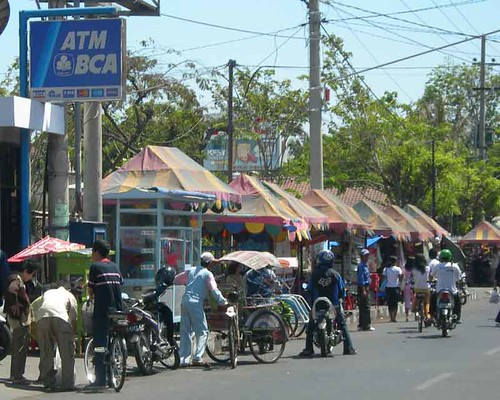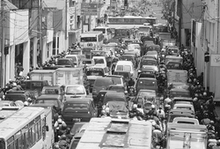Do street vendors deserve urban space?
We often find problems associated with street vendors (pedagang kakilima) in many Indonesian cities. Street vendors do their activities in the sidewalks, city parks, cross walking bridges, and even in the streets. They are often seen as eye-sores and undesirable activities. In many cases, authorities forcibly evict street vendors in the name of urban order and cleanliness. Street vendors often resist the eviction and demand spaces for their activities. Do street vendors deserve urban space for their activities? To answer this question, I would like introduce the concept of urban informality as a framework for understanding street vendors that occur in urban areas. Reference:
Malioboro, Yogyakarta, Indonesia, originally uploaded by Mini Anna {Munandar}.
The concept of urban informality started from the dichotomy between the formal sector and the informal sector discussed in the early 1970s. The informal sector is a very common phenomenon that occurs in developing countries. The percentage of the informal sector in Latin America, Sub-Saharan Africa, the Middle East and North Africa and South Asia ranges between 30-70 percent of the total workforce. In Indonesia, according to data from the Statistics Central Bureau (BPS) in February 2008, 73.53 million out of 102.05 million (72%) workers worked in the informal sectors.
Although the discussions have been conducted for more than thirty years, there is no consensus on the exact definition of the informal sector (Maloney, 2004). Understanding of the informal sector is more often associated with the dichotomy between the formal and the informal sectors. The informal sector is often understood from the document issued by the International Labor Organization (1972). The ILO identified at least seven characters that distinguish these two sectors: (1) easy of entry, (2) easy to obtain raw materials, (3) the nature of ownership, (4) the scale of activities, (5) use of manpower and technology, (6) expertise requirements, and (7) deregulation and market competition.
The dichotomy of the formal and informal sectors often ignores the importance of the informal sectors with respect to urban spaces. The informal sectors are often marginalized in the urban spaces, even though the informal sectors account for 70% of the urban employment.
Ananya Roy and Nezar Alsayyad (2004) introduced the concept of informal urban areas as the logic that explains the process of urban transformation. They did not emphasize on the dichotomy of the formal and the informal sectors but on the understanding that the informal sector is parts of the economic structure of society. The urban informality is an urbanization mode that connects various economic activities and space in urban areas. The informality The inis not only a domain for the poor but also important for middle-class population.
Two urban theories, the Chicago School of Urban Sociology and the Los Angeles School of Urban Geography have dominated the discourse of urban development in developing countries, including in Indonesia. Both urban theories are based on phenomenon that occurred in urban cities in the United States. The Chicago School of Urban Sociology, which was developed in the early 1920s explain the development of the urban migration that is controlled by generating ecological patterns, such as invasion, survival, assimilated, adaptation and cooperation. The Los Angeles School of Urban Geography initiated in the late 1990s to explain the development of metropolitan Los Angeles in the postmodern era that emphasizes the importance of the capitalist economic and political globalization of the economy.
The dominance of both urban theories in the discourse of urban development influences the urban spatial planning in developing countries. Planning practices that replicate both urban theories through the dichotomy of developed and developing countries become ubiquitous. This becomes a problem when such a replication is no longer relevant with the unique urban phenomenon in developing countries, such as the informal sector.
Pedagang di Jl. Dr. Soetomo, originally uploaded by Abdul Manan. The problems that arise in connection with street vendors is mostly caused by the lack of urban spaces for street vendors. The urban spatial planning that is not based on the understanding of urban informality concept will tend to ignore the demand for spaces to accommodate the informal sector, including street vendors. In addition, the dominance of the Chicago and Los Angeles Schools in the practice of urban planning in Indonesia has contributed to the lack of spaces for the informal sectors in urban areas. The spaces in urban areas are dominated by the urban sectors that have high economic value and the spaces for the informal sectors are marginalized.
The application of the concept of urban informality in understanding the phenomenon of street vendors will change our perspective on the existence of street vendors in urban areas. The street vendors are not the groups failed to enter the economic system in urban areas. They are one of the modes in the urban transformation that cannot be separated from the urban economy. They are one component of the urban economy that will benefit urban development.
The phenomenon of street vendors in Indonesian cities should be interpreted in the context of urban transformation. The application of the concept of urban informality in the practice of urban planning will allocate more urban spaces for the street vendors and integrate it with the formal sectors. The practice of urban planning in Indonesia also should not replicate the Chicago and Los Angeles schools, but modify them and take into account the unique urban phenomenon including the informal sector. The informal sectors, including street vendors, deserve more urban spaces to accommodate their activities that are parts of the urban economic system.
The new spatial planning law 26/2007 has stipulated the importance of the informal sector in urban areas, but the implementation of this new law is not fully enforced yet. The full enforcement of the new spatial planning law and the understanding of the urban informality concept are needed to ensure the availability of urban spaces for the street vendors.
(This article also appeared at The Jakarta Post on November 8, 2008)




2 comments:
Nice post on the urban vendors and the informal sector. I am for the vendors and I would hate to see them go from Jakarta. They should be accommodated in the city planning laws. Even if the vendors are not accommodated the informal economy will always find a way to subvert the rules. Also I would much rather see a food cart on the street than another car.
And wow! just look at all that good food in the photo! THAT really makes me miss Jakarta,
My article in the Jakarta Post received an interesting response from Rodney Jensen, who has been working in Yogyakarta and Jakarta. His article provides possible solutions for providing urban spaces for street vendors, as you can find in the following link
Post a Comment